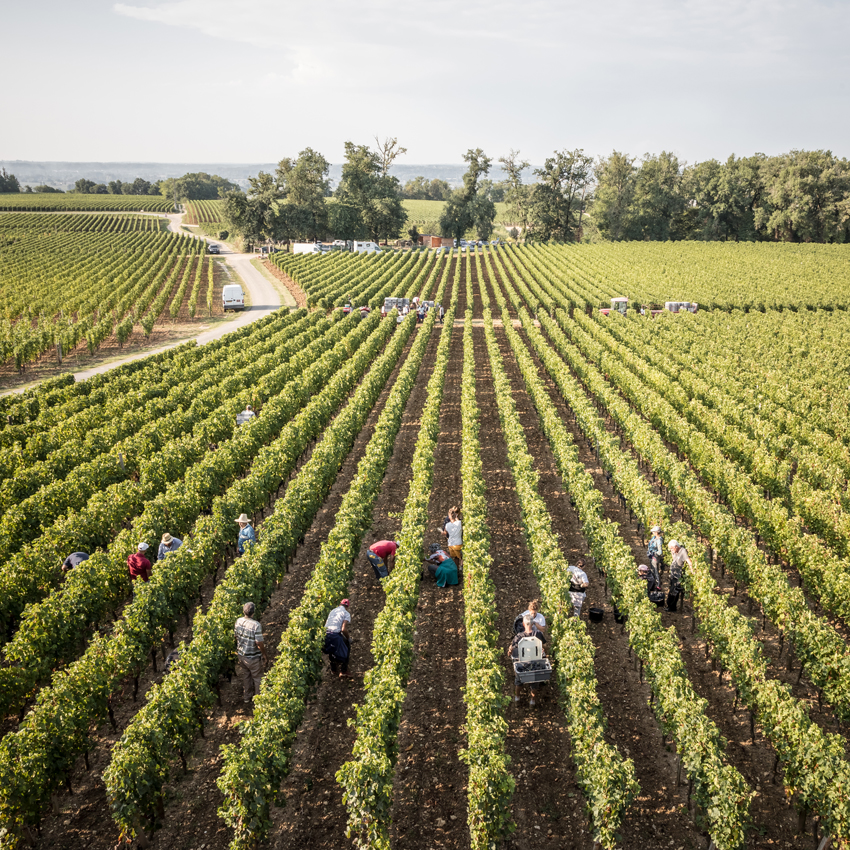Bordeaux 2020: St Emilion
Author: Mark Pardoe MW

In this series, Mark Pardoe MW provides insight into how Bordeaux’s key communes fared in 2020. Here, our Wine Director looks at St Emilion, based on conversations with Frédéric Faye of Ch. Figeac and Aymeric de Gironde of Ch. Troplong Mondot.
At a glance: St Emilion in 2020
- Hectares under vine: 5,450
- Average yield: 38hl/ha in 2020 (44hl/ha in ’19); down 13%
- Significant châteaux: Angélus, Ausone, Cheval Blanc, Pavie; Beauséjour, Beau-Séjour Bécot, Canon, Canon La Gaffelière, Figeac, Clos Fourtet, La Gaffelière, Larcis Ducasse, La Mondotte, Pavie Macquin, Troplong Mondot, Valandraud; Berliquet, Laroque, Quinault l’Enclos, Moulin Saint-Georges, Quintus
In this post, there are two points of view offered. This is to represent the two different terroirs of prime St Emilion: the gravels in the north-west of the appellation, and the clay/limestone slopes around the town of St Emilion itself.
St Emilion 2020: Ch. Figeac
The former is represented by Frédéric Faye of Ch. Figeac. While most of the growing season echoed that of the Médoc, there was a key difference here: the volume and frequency of rain in August. The start of the season was like elsewhere: an early warm period brought the vines nearly three weeks in advance; flowering was successful but cold and wet on either side of the event, with subsequent mildew pressure but without any significant impact on yields.
As the season progressed, Frédéric was keen to highlight the importance of strategic decisions. He and his team had anticipated a hot summer; they took the decision to minimise leaf removal and to protect the younger vines. They did this by reducing potential yield through green harvests and, as the ground dried, by ploughing to introduce humidity into the soil. He quoted an old vigneron maxim relevant to young plants without the benefit of well-established roots: “one ploughing is the same as two waterings.”
St Emilion’s climate is less maritime than the Médoc’s; the nights remained sufficiently cool throughout the summer. The rain, when it came, was less concentrated than in the Médoc, and more regular; this allowed a quicker evolution towards maturity, to such a degree that the grape pips were brown and ripe by the end of August.
Harvest at Ch. Figeac
With the knowledge that the tannins were already in prime condition, the harvest decisions were taken according to each plot’s stylistic contribution. Accordingly, the harvest lasted for four weeks across the three grape varieties. This is absolutely a Cabernet vintage (both Sauvignon and Franc), in Frédéric’s opinion. The superb tannins required only gentle extraction and a longer, cooler fermentation.
The region’s mitigation of the summer heat is evident in this year’s yield here. It is, in fact, 15% higher than in ’19 (although that was a vintage touched a little by frost). For Frédéric, the joy of the wine is its juxtaposition between the bright freshness of the fruit, and the intense-yet-suave tannins and structure.
St Emilion 2020: Troplong Mondot
For Aymeric de Gironde at Ch. Troplong Mondot, ’20 is “a year to forget and a vintage to keep”. The basis for a great vintage on St Emilion’s limestone côtes is to have a wet winter, to create a solid reserve of water and humidity. But ’20 is also a vintage of extremes: the desired volume of water at the start of the year; very mild weather during the first lockdown led to a very early budbreak; a cool end of spring and then no rain in July (just 2.8 millimetres for the whole of July at Troplong, the lowest July figures in their records); and August was also quite dry with just 32 millimetres.
The mildew attack was managed well, using the experienced gained in ’16 and ’18. Troplong is, famously, at the appellation’s highest point, so there is plenty of air movement. But, nevertheless, spray treatments when required had to be immediate. When short-handed and the vineyards inaccessible to tractors after the rain, everyone available at the estate was deployed to spray by hand, including all the executive and office team, and even their recently Michelin-anointed chef.
Harvest at Ch. Troplong Mondot
Harvest began at their earliest date on record on 4th September. The high temperatures of that month accelerated the ripeness, as well as necessitating early-morning harvests; they finished by 11am, to preserve the “croquante” (crunchy) aspects of the aromas and tastes. In the winery, the grapes were cooled immediately, and a fast fermentation was followed by a long cuvaison (skin contact). Normally, there is a danger of extracting bitter elements if this process is too long. But it is a signature of the vintage that the tannins were so ripe, but without losing their structure, that no bitterness appeared; the wine retained purity and freshness and gained more depth.
Troplong does not seem to have received as much rain in August as elsewhere. The month, though warm, was not as hot as July or the start of September when, over the first weekend of the month, temperatures reached 38°C. But there was no drought stress in the vineyard at any time, and the leaves remained bright green throughout the summer. The clay and limestone were able to receive and hold all the water from the start of the year – ideal conditions, in fact.
Since his arrival in ’17, Aymeric has throttled back considerably on the level of ripeness and extraction for which Troplong had become known. In ’20, he has made his best wine so far; he ventures it is probably the best here since ’00.
For more Bordeaux 2020 En Primeur coverage, you can visit bbr.com or browse our range of Bordeaux 2020 virtual events.


